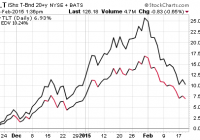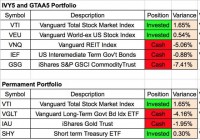
The pullback in Treasury bond ETFs over the last three weeks has caught many fixed-income investors off guard. This flight to quality seemed like a no-brainer at the time given the uncertainty surrounding the direction of equities. However, those that bought near the January highs may be feeling some buyer’s remorse as the focus shifts to better than expected economic data. The pullback in Treasury bond ETFs over the last three weeks has caught many fixed-income investors off guard. The stock market volatility in January pushed yields on the 30-Year Treasury Note Yield (TYX) to all-time lows, which consequently led to strength in funds such as the iShares 20+ Year Treasury Bond ETF (NYSEARCA: TLT ) and the Vanguard Extended Duration ETF (NYSEARCA: EDV ). This flight to quality seemed like a no-brainer at the time given the uncertainty surrounding the direction of equities and the unbelievable low and/or negative yields in international bond markets. A credit-risk free U.S. Treasury trending strongly higher and with yields many times higher than an equivalent foreign issuer was just too good to pass up. However, those that bought near the January highs may be feeling some buyer’s remorse as the focus shifts to better than expected economic data fueling expectations of a 2015 Fed rate hike. Of course, longer duration securities are going to be far more susceptible to interest rate swings as we experience a pullback in bullish sentiment for Treasuries. As you can see in the 3-month chart below, TLT is roughly 10% off its high, while EDV is approximately 15% lower. Both ETFs are now showing essentially flat performance in 2015. According to data from ETF.com , investors poured nearly $1 billion of combined assets into TLT, EDV, and the iShares 7-10 Year Treasury Bond ETF (NYSEARCA: IEF ) as prices peaked in January. Just like in stocks, fixed-income investors tend to chase performance right until they shake the last bullish penny out of the market. So the real question now is – where do interest rates go from here and how should you position your bond portfolio to adapt to these changes? There are really two key paths this trade is likely to follow: The pullback in bonds, with stocks near their highs, is actually a more solid setup for defensive assets to perform on another swoon in the equity markets. Put simply, bonds are now at more attractive “flight to quality” levels than they were at the January peak should we see volatility return to the stock market. The other scenario involves a continued push higher in the equity markets with a concomitant ramp up in Treasury bond yields (lower bond prices). This would align closer with a mid-year or late-2015 Fed rate hike for those that want to dump their interest-rate sensitive asset classes ahead of this move. I wouldn’t give much of an edge to either scenario given the unpredictable nature of the markets over the last few months. Instead, my primary focus is on managing risk for my clients by making sure my fixed-income holdings are well-positioned to ride out these fluctuations. That started in early February when we let go of the Vanguard Intermediate-Term Government Bond ETF (NASDAQ: VGIT ), as bond yields had appeared to make a sharp low. This position was originally established to help balance out credit sensitive holdings in high yield and emerging market bonds. However, it made sense to sell this ETF into strength as a function of a tactical shift in interest rates. We have retained core holdings in the PIMCO Income Fund (MUTF: PONDX ) and the DoubleLine Total Return Fund (MUTF: DBLTX ) as risk-aware actively managed strategies that have shown a penchant for stronger returns and lower volatility than passive counterparts . Ultimately, the way forward for your bond exposure should be governed by your asset allocation, cost basis, and investment goals. If you have significant exposure to stocks or high yield investments, then pairing that with quality Treasury or investment grade corporate bond holdings makes sense to balance out your portfolio. However, if you find yourself with outsized exposure to interest-rate sensitive asset classes, then you may want to consider pairing back on those themes at an appropriate juncture to reduce that focus. You may be better served with a multi-sleeved approach that allows for comprehensive income and capital appreciation through a variety of asset classes. Disclosure: The author is long PONDX, DBLTX. (More…) The author wrote this article themselves, and it expresses their own opinions. The author is not receiving compensation for it. The author has no business relationship with any company whose stock is mentioned in this article. Additional disclosure: David Fabian, FMD Capital Management, and/or clients may hold positions in the ETFs and mutual funds mentioned above. The commentary does not constitute individualized investment advice. The opinions offered herein are not personalized recommendations to buy, sell, or hold securities.

